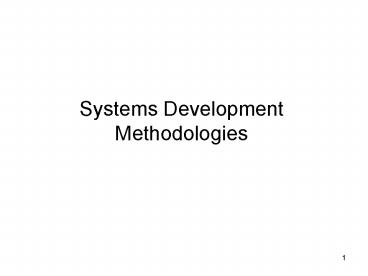Systems Development Methodologies - PowerPoint PPT Presentation
1 / 30
Title:
Systems Development Methodologies
Description:
Systems are collections of objects with their own properties. ... Designer. Information System Model. Interface Requirements. Function and Process Decomposition ... – PowerPoint PPT presentation
Number of Views:123
Avg rating:3.0/5.0
Title: Systems Development Methodologies
1
Systems Development Methodologies
2
- The Nature of a Method
- Methods (or Methodologies) are systematic
approaches to solving a problem.
3
- A common approach to problem solving
- Divide problem into sub-problems until they are
sufficiently small to be understood. - Solve the sub-problems.
- Synthesise the sub-problems into a complete
solution.
4
Common Model for solving difficult problems.
But How do you break the problem down? How do
you do the sythesis?
5
- Systems development problems can be broken down
to smaller problems using - Systems Theory
- Lifecycles
- Information Systems Architecture
6
- Systems Theory (1) Process Oriented
- A system has inputs from its environment and it
outputs to its environment.
A business system is composed of people,
material, facilities, equipment and methods to
supply goods or services.
7
- Systems Theory (2) Object Oriented
- Systems are collections of objects with their own
properties. These objects interact with one
another.
Business objects are those things which assist a
business to reach its goals. Eg. A person, some
thing, a transaction that performs a function.
8
- Systems Theory (3) Paradigms
- A paradigm may be defined as a way of thinking or
mindset to understand reality. - In Economics (Keynesians/ Market Rationalists)
- In Psychology (Freudians and Jungians) etc
- For Systems Analysis there are three main
paradigms - Structured Analysis Process oriented
- Information Engineering Data and business
alignment oriented - Object Oriented Analysis User view, class
oriented
9
- Paradigm shifts in Systems Analysis
- in the 1970s from Ad Hoc to Structured Analysis
- in the 1980s from Structured Analysis to
Information Engineering - in the 1990s from Information Engineering to
Object Oriented.
10
- Information Systems Architecture
11
- Lifecycles
A System Life Cycle divides the life of an
information system into two, systems development
and systems operation and support.
12
An example of a system development life
cycle Planning Analysis Design Build I
mplement Operate Here the phases provide
the input to the next phase and feedback to one
another. There are many other SDLCs.
13
(No Transcript)
14
- The need for
- Systems that meet the users needs, are within
budget, and are on time - Require
- an organised, consistent method for the solution
of systems problems. - Methods (Methodologies) are derived from
- Systems lifecycles, Systems theory, Analysis by
abstraction
15
- Methods provide
- A set of steps to follow assist project
management - A set of techniques to use to model the system
- A set of deliverable to define and document each
step of the analysis - A set of standards to follow.
16
(No Transcript)
17
(No Transcript)
18
(No Transcript)
19
(No Transcript)
20
(No Transcript)
21
(No Transcript)
22
(No Transcript)
23
(No Transcript)
24
(No Transcript)
25
(No Transcript)
26
(No Transcript)
27
(No Transcript)
28
(No Transcript)
29
(No Transcript)
30
(No Transcript)

